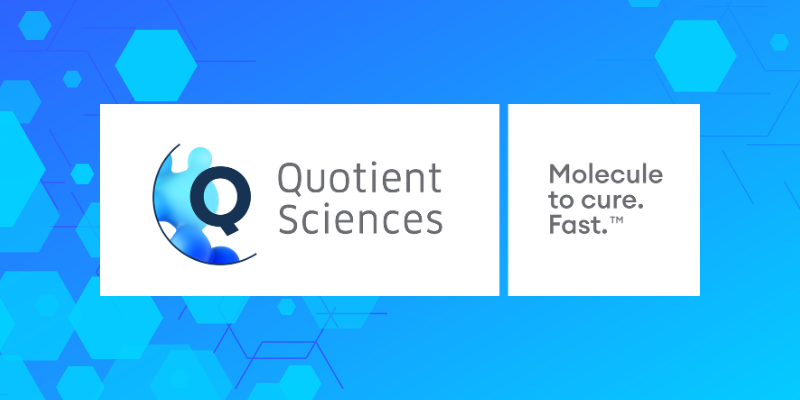Gareth Jenkins, VP Science and Technology, Candidate Development Services at Quotient Sciences, Contributes to Chemistry Today Panel Discussion on Flow Chemistry. Read Gareth's contributions to this panel discussion with Chemistry Today July/August 2022 issue.
For what types of reactions do you consider flow chemistry most useful?
Highly energetic and very fast reactions are more easily engineered and controlled using continuous processing than in batch. Similarly, if we are looking at a process with highly hazardous material and we want to minimize the risk, continuous processing can provide that basis of safety. We recently ran a process with liquid bromine that would have been much more complex to handle safely in batch than using the very simple set-up of a couple of pumps and a flow reactor.
What are the typical scales in which continuous manufacturing processes are carried out in your organization?
Quotient Sciences is a drug development and manufacturing accelerator, so most of our chemistry projects are in very early development. Often we are looking at the first scale-up of a new drug candidate from gram to kilogram scale to support pre-clinical evaluation and Phase 1/2 clinical development. Our flow chemistry is, therefore, targeted towards making a few kilograms to a few 10s of kilograms of the active pharmaceutical ingredient (API). This means that we can keep the flow reactors very small, stay within a laboratory environment, and produce multi-kilogram quantities per day.
Are you utilizing commercial flow reactors or home-built systems?
This is one of the key advantages of flow chemistry, which can often get overlooked. The reactors themselves can be very simple. Often a piece of stainless-steel tube or an off-the-shelf static mixer is all that is needed for the reactor, and it is very easy to quickly modify to adjust for different flow rates or residence times as we develop the process. The equipment around the reactors, such as pumps, mass flow meters, and back pressure regulators, is also generally commercially available. For example, we now have a wide variety of different pumps that can be brought together for each new process we are looking at. This is where we need some chemical engineering experience within the team to help guide the selection of the best pump for the materials and flow rates we are going to need.
How important is collaboration for your organization in view of knowledge transfer and expanding skillsets in flow chemistry?
Our adoption of flow chemistry was accelerated through an Innovate UK-funded collaboration with Professor Michael George and Professor Martyn Poliakoff at the University of Nottingham, which also supported the creation of an internal ‘Flow Chemistry R&D’ team at our Alnwick site. From 2018 to 2021, this enabled us to demonstrate that flow chemistry can provide significant benefits for rapid and robust delivery of material to support pharmaceutical development, and this is now firmly embedded within our chemistry team.
Process analytical technology (PAT) and artificial intelligence (AI)-assisted methods are a growing topic this decade. Do you see advantages of implementing these technologies in flow compared with batch?
Flow reactors operate with minimal operator interventions. Flow rates are set on the pump controllers, the pressure is established using a back pressure regulator, and the temperature is established using temperature control units. As most of these process parameters can be interfaced into a process control system, it is very easy to also add PAT and use that to measure the output. The next logical step is to build a feedback loop from the outputs to control the process parameter inputs. Putting all of this into an algorithm means that it is possible to automate the screening of a variety of process parameters, such as temperature. We start with a particular residence time and reaction temperature and use an algorithm to assess what happens if we change the temperature in 5°C steps or if we change the residence time in 30-second steps. Using the very small-scale flow reactors based on narrow-bore, high-performance liquid chromatography (HPLC) tubing, it becomes very quick and material-sparing to rapidly screen a wide range of process conditions. This can help with our process understanding to identify where the edge of failure might be for a particular reaction.
What are the main barriers to wider adoption of flow chemistry in some sectors (e.g. the pharmaceutical industry)?
There has been considerable uptake in flow chemistry across the pharmaceutical industry over the past few years, with many companies establishing flow chemistry within their process development groups. With the recent ICH Q13 guidance on continuous processing close to being finalized, the perceived regulatory barrier is also much lower. Over time, we will see more APIs manufactured with at least one stage by flow chemistry.
Do you think that flow chemistry is a valuable contributor to realizing more sustainable chemistry, e.g. by reducing the carbon footprint in your organization?
Flow chemistry, especially continuous manufacturing, does have a role to play in helping to move the fine chemical and pharmaceutical industries to a more sustainable future. We have recently published an example of a chemoselective conjugate reduction by continuous hydrogenation. A heterogeneous catalyst was used in a packed bed reactor, and the continuous process demonstrated at least 8 of the 12 principles of green chemistry, scoring 77/100 using the GreenMotion metric. The biggest impact was greater selectivity, which led to less waste, a greater E-factor, and improved quality of the final product.
What challenges still remain?
One of the key advantages of early flow chemistry was the ability to access chemistry processing space that was not possible in a batch reactor, such as high-pressure/high-temperature chemistry, above the boiling point of the main solvent. This is now a well-understood reason to use flow chemistry, with many excellent examples. Two similar types of chemistry processing are photochemistry and electrochemistry, which offer novel chemistry but are very difficult to scale up using a batch reactor. There are some research-scale flow electrochemical and photochemical reactors, and it would be great to see some larger-scale equipment become available.

